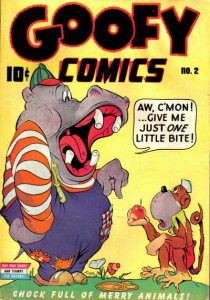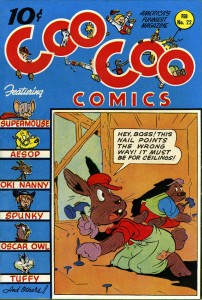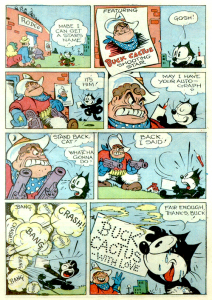
Fellow readers, after 80 columns dedicated to animator breakdowns, I feel that it’s time for a change of pace —this doesn’t mean the end for the breakdowns, but I’ve had this idea in my head for quite some time. This new column will profile the connection between Golden Age animators and “funny animal” comics. There will be a switch from the subject of animator drafts and funny animal comics from hereon in.
On the subject of Golden Age animators working on “funny animal” stories, many readers might understand why former Disney artists Carl Barks and Walt Kelly went on to greater acclaim, drawing and writing for comic books, after they left animation. However, there were a large number of animators who freelanced in such fare, in addition to their regular studio jobs, especially those in the East Coast studios.
 In the early 1940s, one of the more popular genres of comic books besides superheroes were “funny animal” stories—Dell Comics published two different series of magazines based on the popular animated characters, Walt Disney’s Comics & Stories and Looney Tunes and Merrie Melodies Comics. Their later magazines New Funnies featured Walter Lantz characters, Our Gang Comics covered the MGM cartoons and Animal Comics, for a stretch in 1944, did adaptations of Famous Studios characters.
In the early 1940s, one of the more popular genres of comic books besides superheroes were “funny animal” stories—Dell Comics published two different series of magazines based on the popular animated characters, Walt Disney’s Comics & Stories and Looney Tunes and Merrie Melodies Comics. Their later magazines New Funnies featured Walter Lantz characters, Our Gang Comics covered the MGM cartoons and Animal Comics, for a stretch in 1944, did adaptations of Famous Studios characters.
To capitalize on Dell’s success, Ned L. Pines, owner of the Nedor Publishing Company, convinced publisher Benjamin W. Sangor to issue monthly comics with original talking funny animals through his Cinema Comics outfit, operated on 45 West Forty-fifth Street in New York.
When Paramount’s Famous Studios returned to New York from Miami in early 1943, many of its animators worked on Sangor’s “funny animal” stories in their spare time. The studio was in close proximity to the Cinema Comics building. Famous Studios was located on 25 West Forty-Fifth Street. In addition to the pay from the animation studios, these artists were given $15/page for an eight-page story on a 64-page magazine. (By 1944, this shrank to 48 pages, due to wartime paper shortages.)
Arguably, the most prominent animator from Famous Studios to freelance on funny animal stories was Jim Tyer, at the time serving as head animator/de-facto director on the Popeye cartoons. His style of drawing displayed a wild, eccentric energy and spontaneity, which matched strikingly with his comic book work.
Tyer’s stories inaugurated Sangor’s line of comic book magazines—including Coo-Coo, Giggle, Ha-Ha, Goofy and Happy Comics — by the fall of 1943. (His stories for Barnyard Comics occurred in its second issue, in 1944.) In addition to the stories, Tyer also drew various covers, illustrations placed in text stories, and even the logos (particularly, for Giggle and Ha-Ha) for their early issues.




Around 1946, original comic book stories starring Felix the Cat appeared in issues of Four Color, published by Dell Comics; previous Four Color magazines with Felix were reprints of earlier newspaper strip adventures. Otto Messmer, responsible for the success and popularity of the Felix cartoons during the 1920s, was working for the Douglas Leigh Organization, creating animation for electric signs. He enlisted Tyer and Joe Oriolo to assist him with the new Felix stories.
In issue #119 (September 1946), Tyer worked on the Felix story, “Ancient Egypt”, where Felix brings merriment to a bored kingdom by inadvertently “inventing” various musical instruments; in one instance, he uses serving trays to capture a fly, with each hit creating a musical “CLANG”. The king sees this, and clashes them together in merriment, enjoying the new discovery of cymbals. Tyer hadn’t drawn many Felix stories for Dell—instead, he drew selected pages for the next Four Color special with Felix, in issue #135 (February 1947) for the stories “Starburst” and “The Great Inventor.” For issue #162 (September 1947), Tyer took over most of the drawing duties for the story “Weather Profit”.
Besides the magazines published by Cinema Comics and Dell, Tyer also worked for other established publishers, including one story for Timely Publications’ (later evolved into Marvel Comics) Krazy Komics, issue #23, published August 1946 — Casper Cat in “O Sol-o Mioz”. Tyer also worked on a story with Chad Grothkopf’s Sherlock Monk and Chuck the Duck for Fawcett’s Funny Animals — issue #55, published November 1947.Later, Felix the Cat was given his own series of comics from Dell by early 1948. Messmer (and presumably Joe Oriolo) drew the first several pages, and Tyer handled the remainder of the stories “Misdeal” and “Laffographs” in the first issue, published February-March 1948. In issue #3, Tyer was given his own Felix story, “Solo Fright”, for issue #3 (June-July 1948).
In most cases for Golden Age funny animal comics, a studio animator’s drawing style in a comic book story helps identify their work in an animated film. This reel containing Jim Tyer’s animation for Van Beuren, Jam Handy, Famous Studios, Terrytoons — and his work for television animation for ex-Famous animators Joe Oriolo, Hal Seeger and Paramount’s King Features — might provide an insight on the parallel between animators’ studio jobs and freelance work for comic books.
Sorry to have to do this right at the start of a new column, but due to a very busy movie shoot (as a script supervisor), with production days often lasting up to 12 hours and, in addition to my regular job, the time to prepare another for next week isn’t looking so good. The week after (November 2), Jim Tyer’s comic book career will continue to be profiled, touching upon his later work on the Terrytoons characters, and stories from the 1960s. Click HERE for Part 2.
In the meantime, you can look at several of Tyer’s stories from the Sangor line of comics, compiled into three different collections, here.

Paul Terry keeps a close watch on animator Jim Tyer at Terrytoons. “No moonlighting on the job!”
(Thanks to Michael Barrier, Frank Young for their help.)



 DEVON BAXTER is a film restoration artist, video editor, and animation researcher/writer currently residing in Pennsylvania. He also hosts a
DEVON BAXTER is a film restoration artist, video editor, and animation researcher/writer currently residing in Pennsylvania. He also hosts a 





















































































Tyer’s connection to Oriolo and the Felix comics may explain his decision to leave Terrytoons and go to work on the made-for-TV Felix series shortly after Gene Dietch was ousted from the studio.
Wow, Tyer + Felix is a great match!
I wholeheartedly agree!
I like the Tyer mouth on Felix in the third panel. Very similar to his animation of Olive in “W’ere [sic] On Our Way to Rio”.
Oh, man! What a great idea for a column, Devon!
Jim Tyer is the perfect place to start your journey — and I can’t wait to see your profiles and examples of the many West Coast animators who moonlighted for Better/Nedor/ ACG/Pines through their ‘agent’, Jim Davis!
BRAVO for shining a light on this great niche of animation history!
Are there any press photos or portrait photos of Jim Tyer solely, that are known to exist?
I have a few other photos of Tyer – none of them formal portraits or press photos.
It’s highly unlikely that individual animators would have had formal portraits at that time, unless they paid for it themselves for personal use (like a family portrait or some such). As for press photos, the press at the time concentrated more on the producers running the animation studios than the hundreds of anonymous artists working for them.
Thank you Jerry and Tony. However while researching Jam Handy, I’ve stumbled on press photos for folks in all sorts of job positions at Jam Handy (i.e. I found one for a gentleman who as a sound engineer for the filmstrip division). Since Tyer did do work for Handy, and was apparently employed by the studio at one time period, it’s possible that a portrait photo was indeed taken of him. I’ll keep my eyes out for one…
The sample reel of Jim Tyer’s work is one of those few instances where I appreciate a bad internet connection. The video keeps on stopping on random frames you might never choose on your own!
NEW FUNNIES was hardly a “later title,” Devon–it was one of the oldest comic books at the time, having begun as THE FUNNIES in October, 1936–four years before WDC&S was launched, and five years before the start of the LOONEY TUNES title.
I would be grateful for anyone who could list Tyer work in the Terrytoons line of comics. A lot of his other work is in the public domain and available online. The Terrytoons comics are not public domain and I hesitate to purchase any without knowing for sure that they include Tyer.
Now, let me get this straight.
A character was called “Supermouse” for three cartoons in 1942 and 1943.
According to lore, Paul Terry changed the name to “Mighty Mouse” after “one of his artists” went over to “Coo Coo Comics”, which began publishing adventures of “Supermouse”.
According to this narrative. Terry changed the name, at a time when there was no deal between Paul Terry and any of the comics publishers. That would come later.
IF the above is so–then could it be possible that the “one of his artists” who left Terry for “Coo Coo Comics” was Jim Tyer himself?
I am not aware that the American Comics Group (ACG) ever had any connection with the various lines of comics published by Leo Maguies’ “Thrilling” group of magazines. These lines included Standard, Nedor and Better Comics groups.
Later–around 1957 or so–Ned Pines of the Popular Library series of paperbacks got into the comics business. He published under his Pines banner some Terrytoons-derived comics, which also had the CBS Eye on their covers.
Jim Tyer was at Famous Studios in 1942 and 1943. He didn’t move to Terrytoons until 1946 or 1947.
You can really see he must have been a huge influence on Milton Knight’s work.